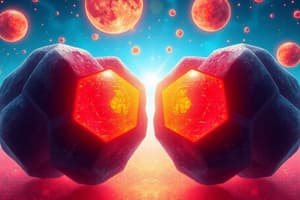Podcast
Questions and Answers
What is formed when sodium loses an electron?
What is formed when sodium loses an electron?
- Na2+ ion
- Na+ ion (correct)
- Na- ion
- NaCl molecule
What electronic configuration does chlorine achieve when it gains an electron?
What electronic configuration does chlorine achieve when it gains an electron?
- 2, 8, 7
- 2, 8, 8 (correct)
- 2, 7, 8
- 2, 8, 6
What type of bond is formed between sodium and chlorine?
What type of bond is formed between sodium and chlorine?
- Covalent bond
- Hydrogen bond
- Metallic bond
- Ionic bond (correct)
What charge does the sodium ion have after losing an electron?
What charge does the sodium ion have after losing an electron?
In the formation of NaCl, what happens to the electrons transferred from sodium to chlorine?
In the formation of NaCl, what happens to the electrons transferred from sodium to chlorine?
Flashcards are hidden until you start studying
Study Notes
Formation of Sodium Chloride
- Ionic bonding occurs when a metallic element loses electrons to a non-metallic element, creating ions.
- Sodium (Na) has an electron configuration of 2, 8, 1 and can lose one electron to form Na+ (2, 8).
- Chlorine (Cl) has a configuration of 2, 8, 7 and can gain one electron to form Cl- (2, 8, 8).
- The oppositely charged ions (Na+ and Cl-) attract each other, forming sodium chloride (NaCl).
Properties of Metallic Bonds
- Strong metallic bonds, such as in iron, make metals difficult to break; weaker bonds, like in sodium, allow cutting with a knife.
- Metals are effective conductors of heat and electricity due to mobile electrons that can move freely.
- Many metals exhibit malleability and ductility, being able to withstand stress without breaking.
Hydrogen Bonds
- Hydrogen bonds form when hydrogen is covalently bonded to electronegative elements (N, O, F).
- These bonds arise from the dipole created by the unequal sharing of electrons, causing electrostatic attraction.
- Hydrogen bonds elevate the melting and boiling points of compounds containing them.
Air Composition and Reactions
- Air comprises nitrogen (78%), oxygen, and trace impurities.
- Chemical reactions in air can release various products upon heating, such as:
- 2Mg + O2 → 2MgO (magnesium oxide)
- C + O2 → CO2 (carbon dioxide from complete combustion)
- 2C + O2 → 2CO (carbon monoxide from incomplete combustion).
Properties of Ionic Compounds
- Ionic compounds consist of aggregates of charged ions rather than discrete molecules.
- They dissolve well in polar solvents (e.g., water) but not in non-polar solvents (e.g., benzene).
- Ionic compounds are solid at room temperature, have high melting/boiling points, and conduct electricity when molten or dissolved in water.
Covalent Bonds
- Covalent bonds involve the sharing of electron pairs between atoms, leading to stable molecules such as Cl2.
- Each chlorine atom shares one electron, resulting in each atom achieving a complete outer shell.
- Property: Covalent compounds typically exist as gases or liquids with low melting and boiling points.
Properties of Covalent Compounds
- Many covalent compounds are gases or liquids at room temperature due to weak intermolecular forces.
- They are generally soluble in organic solvents and do not conduct electricity due to the absence of ions.
- Co-ordinate (or dative) bonds involve one atom providing both electrons for the shared pair, as seen in compounds like ammonia (NH3).
Characteristics of Metallic Bonds
- Metallic bonds involve free-moving valence electrons in a crystal lattice, allowing for high electrical and thermal conductivity.
- Metals typically possess high melting and boiling points due to the strong attractions between metal ions and the electron cloud.
Co-ordinate Covalent Bonds
- In co-ordinate covalent bonds, one atom donates both electrons for the bond, forming a lone pair.
- Examples include the interaction between ammonia and hydrochloric acid, producing a co-ordinate covalent bond with the nitrogen atom.
- The properties of co-ordinate covalent compounds closely resemble those of standard covalent compounds.
Studying That Suits You
Use AI to generate personalized quizzes and flashcards to suit your learning preferences.




